NMO S5 Semi Final | BUSINESS CASE SCENARIO - 14 | Airway Delivery: A New Business Opportunity
Submission BCS
Optimal Budget Allocation across departments and Break-even Analysis
Submission Date & Time: 2023-11-19 15:27:24
Event Name: NMO Season 5 Semi Final
Solution Submitted By: Piyush Mehta
Assignment Taken
Proposed a Financial plan for Airway delivery for FY 2023-24 including Budget Allocation and Break-even AnalysisCase Understanding
Airway Delivery, a courier company with an expansive reach across India, is poised to revolutionize its operations by entering the 'Hyper Local Delivery Space' through drone technology. In a strategic move, the company opts to initiate this venture with "Short-Range Drone Based Services," steering away from long-range operations due to the substantial initial costs involved. Crucially, the company has secured essential permissions from the Director General of Civil Aviation (DGCA) and conducted successful beta testing deliveries for various stakeholders, including food delivery firms, pharmaceutical chains, and internal local deliveries. The company's vision extends beyond its initial successes, aiming to diversify and explore additional business areas for cost-effective cargo deliveries. The primary value proposition lies in time-saving, a key element highlighted by users during beta testing. As the newly formed drone division embarks on this transformative journey, it sets ambitious yet strategic goals. First and foremost, the division is committed to achieving the Break-even point within its inaugural year of operations. Simultaneously, the company recognizes the importance of Brand Establishment in this nascent market. Leveraging its already market position in the courier industry, Agile Strategists aims to cultivate a strong and positive brand image for its drone-based services. Furthermore, the drone division aspires to Lead the Market through continuous innovation in processes and products. This includes exploring untapped business areas for cargo deliveries and staying at the forefront of technological advancements in drone operations. To support these ambitious goals, the company has earmarked a budget of Rs. 10 Crore for the Drone Business division in the Financial Year 2023-2024. As the head of the Financial Department, the budget has to be judiciously allocated across various domains, including Drone Operations, Marketing, Technology, and ongoing Research and Development, and more importantly, the Break-even point has to be achieved within first year.BCS Solution Summary
The Drone Business Division, equipped with Short and Long Range Drones, is strategically positioned to revolutionize local deliveries. Fixed costs include a skilled team and software infrastructure. For break-even, depreciation and amortization are considered, adhering to accounting principles. Variable costs, crucial for operations, include drone-related expenses, insurance, communication, navigation, support services, and customization. Assumptions, such as battery replacement frequency, insurance for risk mitigation, communication needs, navigation services, customization expenses, and depreciation based on SLM, are made for accurate financial planning. A budget of Rs. 10 Crores for FY 2023-24 is allocated wisely. Research & Development (21%), Operations & Logistics (20%), Human Resources (15%), Marketing & Promotion (14%), Technology & Software (12%), Contingency (8%), Website Development (7%), Charitable & CSR (2%), and Drone Acquisition (1%) align with division goals. On the revenue side, competitive pricing is crucial. B2B pricing strategies differ from B2C, where elasticity matters. A cost-effective drone service is feasible, given advantages like no delivery partners and zero fuel costs. Break-even analysis reveals the need for 10,094 daily deliveries at Rs. 25 per delivery in the first year. Recommendations include fleet expansion, leveraging the existing network, stringent budget adherence, cost reduction strategies, and potential B2C entry after feasibility checks. The division is poised for success with a strategic financial plan, aligning costs with revenue, and innovative solutions.Solution
Understanding the Expense Side of the Drone Division:
Given that the division already has a management team, software development team, support staff, and qualified drone operators along with 4 Short-range and 1 Long-range drone available with it. These all would account for the fixed costs of the division as irrespective of the operations and scale of the business, these expenses would continue to incur. Also, for defining the break-even sales target, only the depreciation and amortization expense specific to that year has been accounted for, rather than the full amount of the asset.
The rationale behind considering only depreciation as an expense for break-even analysis:
- Matching Principle: Depreciation is recognized as an accounting expense to match the cost of the asset with the revenue it helps generate over its useful life. Including the full amount of the machine in one year would not accurately reflect how the cost of the asset is distributed over time.
- Real Economic Expense: The actual economic expense incurred in a given year is the depreciation expense, not the full cost of the machine. Depreciation reflects the wear and tear or the reduction in the asset's value that occurred during that period.
- Break-Even Calculation: To determine the break-even point, you need to consider the costs that are relevant to the specific period under analysis. Including the entire cost of the asset would not provide an accurate representation of the costs incurred to achieve the break-even point for that year.
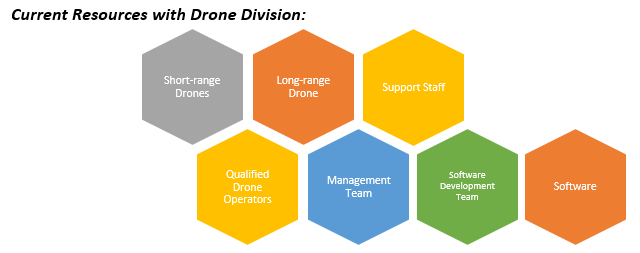
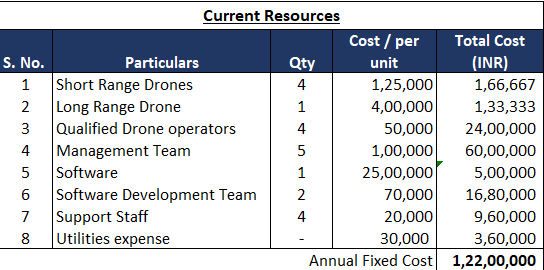
In addition to the resources already at the company's disposal and the associated costs, it is crucial to recognize that there will be additional expenses, particularly those falling under the category of variable costs. Among the variable costs that are linked to the operations of the Drone Business Division, some notable expenses have been identified, and they are as follows:
- Drone Operation Costs: Hourly wages or per-delivery cost of the drone pilots who would manage and control the drones during deliveries
- Energy & Maintenance Cost: Cost for charging the drones, routine maintenance, and any necessary repairs. It also includes battery replacement costs and equipment maintenance.
- Consumables (Batteries): Replacement batteries for electric drones, which may need to be replenished regularly.
- Insurance charges: The cost of insurance to cover any potential accidents or liabilities related to drone operations.
- Communication and Connectivity: Costs related to data plans for real-time communication with drones, tracking, and monitoring.
- Navigation and Mapping: Subscription or usage-based costs for GPS and mapping services to ensure accurate and safe drone routes.
- Customizing Costs: Expenses related to the design, production, and maintenance of packaging and payload protection materials for safe deliveries.
- Logistics and Support: Personnel expenses for managing drone operations, customer support, and dealing with any delivery-related issues.
Assumptions:
- Battery Replacement: It is assumed that the company-owned drones will require battery replacement over time. The frequency of battery replacement depends on the usage of the drones. Drones rely on batteries for their power source, and as these batteries are used, their capacity degrades. Replacing batteries is considered a variable expense because it is directly tied to the number of drone flights and the wear and tear on the batteries. More flights result in more frequent battery replacements.
- Liability Insurance: To mitigate the risks associated with drone operations and protect the company from potential liabilities that may arise due to accidents, damages, or other unforeseen circumstances, the company invests in liability insurance. This insurance coverage is essential to safeguard the company's financial interests and is considered a variable cost since the insurance premium may vary based on factors such as the extent of coverage, claims history, and the number of drones in operation.
- Communication Costs: Effective communication with drones is crucial for their safe and reliable operation. The company incurs communication costs to maintain real-time connectivity with drones. This includes data plans, software, and infrastructure needed for remote monitoring, control, and data exchange with the drones. Communication costs can fluctuate based on the volume of data transmission, the number of active drones, and the coverage area.
- Navigation Expenses: Drones rely on accurate navigation and mapping services to plan routes and ensure safe deliveries. The company may need to subscribe to navigation services, which can include GPS and mapping data. These costs are considered variable because they depend on the extent of drone operations and the frequency of route planning and navigation.
- Customized Service: The company may offer customized services to clients or adapt its drone operations to meet specific requirements. These costs can vary based on the level of customization requested by clients, such as tailored packaging or special delivery instructions. The extent of customization may lead to variable expenses.
- Depreciation Based on Straight-Line Method (SLM): Depreciation is a non-cash expense that accounts for the gradual reduction in the value of assets over time. The assumption here is that the company follows the Straight-Line Method (SLM) for calculating depreciation on its drone assets. Under SLM, the depreciation expense is distributed evenly over the useful life of the drones.
- Useful Life: For depreciation, the useful life of each drone has been assumed as 3 years based on the average life that usually a drone has. Similarly, for amortization expense on end-to-end drone operations software, useful life has been assumed as 5 years.
Budget Allocation:
After Looking at the probable fixed cost and variable costs that would arise for the Drone division during its operations. Allocating the budget wisely for the financial year 2023-24 for the drone division is essential to achieve the division's goals while ensuring financial sustainability. Based on the information provided and the objectives of the division, here's a suggested budget allocation:
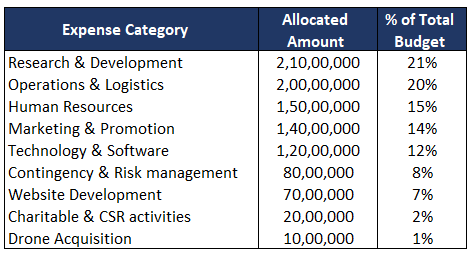
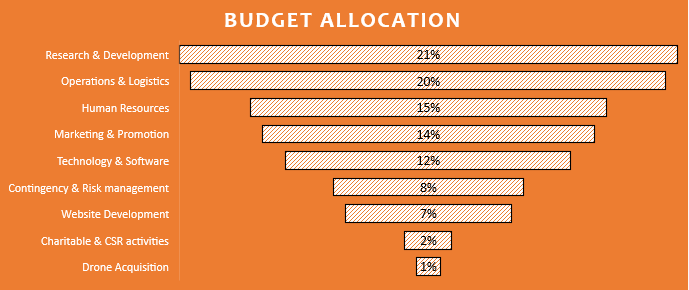
Research and Development (21% of Budget - Rs. 2.1 Crores):
Allocated funds would support research initiatives and development projects aimed at innovation, improving efficiency, and staying ahead in technological advancements.
- Investing in research and development is essential to enhance drone delivery services, improve operational efficiency, and stay competitive in the market, as the drone division is at its initial stage so continuous enhancement in offerings is required.
- Investment in development projects will support the enhancement of drone technology and operational processes.
- Funds for research initiatives are essential also to drive innovation and stay competitive in the rapidly evolving drone industry.
- Consider innovations like autonomous drones, route optimization algorithms, and safety improvements.
Operations and Logistics (20% of the Budget - Rs. 2 Crores):
Significant portion of the Budget is allocated to drone operation costs to ensure the smooth operation of the drones. This includes Battery replacement costs, Maintenance and repair costs, Energy costs, Insurance charges, Communication & Connectivity charges, Navigation and mapping, Customization costs, etc.
- Battery Replacements (Rs. 35 Lakhs) - Battery replacements are crucial for drone operations. Allocating a significant portion ensures that there are ample funds to cover the costs of replacing batteries, which is a regular requirement for drone fleets.
- Maintenance and Repairs (Rs. 40 Lakhs) - Maintenance and repairs are essential for keeping drones in optimal working condition. This budget allocation allows for routine maintenance, inspections, and necessary repairs to ensure the longevity and reliability of the drone fleet.
- Insurance Charges and Safety & Risk Management (Rs. 30 Lakhs) - Insurance is a critical component to cover potential accidents or liabilities related to drone operations. While the actual cost of insurance can vary, allocating a reasonable amount ensures financial protection. Apart from Insurance, the allocated amount is also to be utilized towards safety measures, risk assessments, and protocols implementation to ensure safe drone operations.
- Quality Assurance and Testing (Rs. 15 Lakhs) - Quality assurance and testing are crucial for ensuring the reliability and safety of drone operations. Allocating funds for testing and quality control measures helps maintain high operational standards.
- Communication and Connectivity (Rs. 10 Lakhs) - The budget allocation ensures reliable communication and connectivity with drones, including data plans and real-time monitoring, which are critical for safe and efficient operations.
- Navigation and Mapping (Rs. 20 Lakhs) - Navigation and mapping services are essential for route planning and safety. This allocation covers the costs of GPS and mapping services.
- Customization Costs (Rs. 30 Lakhs) - Customization costs are allocated for tailoring services to meet specific client requirements and will account for the maximum operating cost as it includes specialized packaging and unique delivery instructions, enhancing the customer experience.
- Rent, Utilities, Office Supplies & Logistics (Rs. 20 Lakhs) – For Rent, Utilities, Office Supplies, and other miscellaneous logistical needs that would arise during day-to-day activities, this portion of the allocation can be utilized towards ensuring seamless operations and timely deliveries.
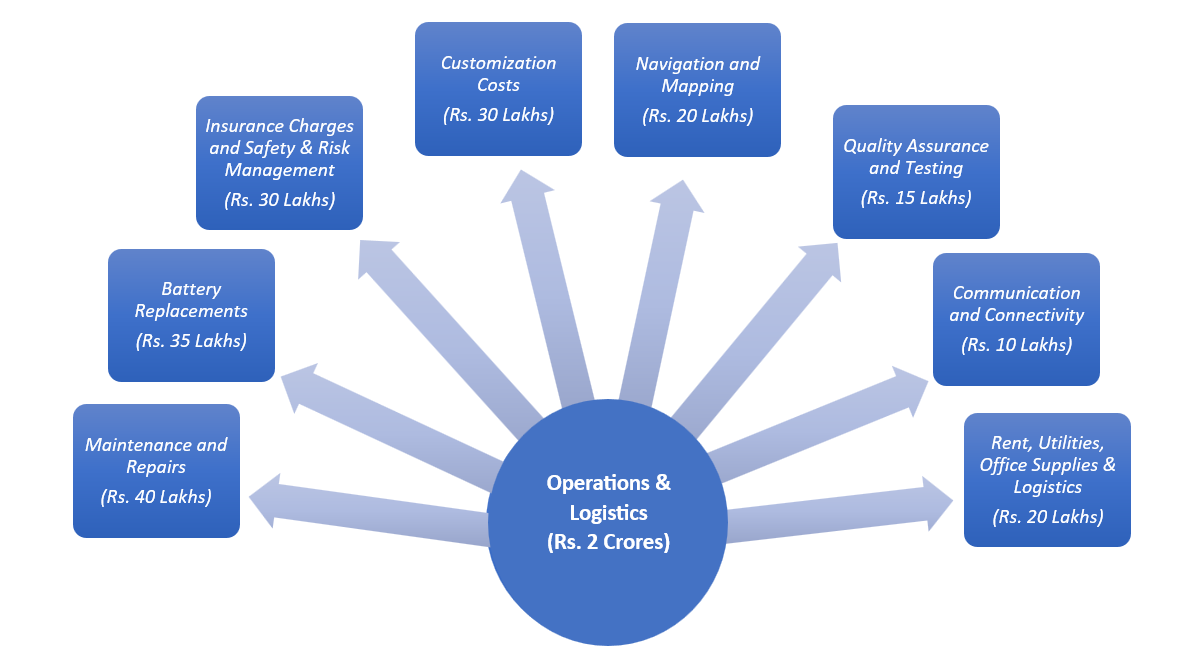
Human Resources (15% of Budget - Rs. 1.5 Crores):
Budget to be allocated for personnel costs, including drone operators, management team, software development team, and support staff. Important to ensure competitive salaries to attract and retain qualified personnel.
- Given Resources – As the case provides, the Drone Division has four Qualified drone Operators, five employees under the Management Team, two employees in the Software Development team, and four Support staff which can also be considered as ground staff who would be handling the cargo. Annual payout for the mentioned personnel accounts for around Rs 1.1 Crores.
- Customer Service Executives – Besides the available personnel, Customer service executives would also be required to handle inquiries, provide support and ensure a positive customer experience. It has been assumed that for the current operational level, three executives would suffice and the monthly payout of each would be Rs. 20,000.
- Performance-linked Incentive Corpus – To motivate the employees and maintain a positive and competitive environment, a portion of the budget has also been allocated for additional benefits to the employees based on their performance which amounts to Rs. 20 lakhs. This is essential to attract and retain skilled personnel, and cannot be ignored
- Training & Development – Additionally, the amount has also been allocated for training programs for the employees including drone operators, and staff, and continuous development to keep the team updated with the latest industry practices. The amount allocated for the training & development program is close to Rs. 15 lakhs.
Marketing and Promotion (14% of Budget - Rs. 1.4 Crores):
Allocated a portion of the budget to marketing and promotion to establish a strong brand presence. This allocation of 14% constitutes the current requirement for B2B model of the drone division, marketing and promotional activity, and provisions for potential entry into B2C segment as well.
- Besides leveraging the existing network and partnerships, significant effort is required to be made on the marketing and promotional end as the drone-based delivery service is still in the infancy stage in India. Hence, additional efforts would be required to promote the service.
- Focus on digital marketing strategies such as SEO & SEM, social media marketing along with local promotions, and partnerships with local businesses. Funds for expanding the client base are needed to explore new business areas and seize growth opportunities.
- Also, new industries and local partnerships are to be tapped to expand the client base and its operations as the business is currently focusing on the B2B model, and once the brand is established in terms of Drone-based delivery service then subsequently the business can look to enter into the B2C model after considering the feasibility, for which provisions amounting to Rs. 40 Lakhs have been set aside.
Technology and Software (12% of Budget – Rs. 1.2 Crores):
Allocated the budget to maintain and upgrade end-to-end drone operations and management system. This is crucial for ensuring smooth and efficient operations. A robust technological infrastructure that supports efficient drone operations, ensures compliance, enhances customer experience, and positions the business for future growth and innovation.
- Software Maintenance and Upgradation (Rs. 30 Lakhs): Having allocated the amount for technology and software maintenance and upgradation will allow the IT department to opt for new disruptive technology without any delay and hampering the existing operations. This will also allow the department to prevent cyberattacks, address the bugs.
- Enhanced Data Analytics (Rs. 25 Lakhs): Through this allocation the department would also be able to make use of technology like predictive analytics, Machine Learning and will support the business through insights into customer behavior, areas for improvement, etc. gained from these models by analyzing the data.
- Servers & Data Storage (Rs. 25 Lakhs): The dedicated budget for servers will serve as the backbone of our digital operations, hosting and managing the vast amount of data generated by our drone-based services. Whether it's real-time flight data, client information, or operational logs, our servers will provide a secure and scalable environment to house and process this information.
- Technology Partnerships and Integration (Rs. 20 Lakhs): A part of the budget is allocated for exploring technology partnerships and integrating third-party solutions that align with the business's objectives. This ensures that the drone delivery business remains at the forefront of technological innovation in the industry.
- Training Simulators (Rs. 20 Lakhs): If the business requires, can also utilize the part of the budget allocated to the department for training simulators and simulation software, this would also enhance the operational efficiency.
Contingency and Risk Management (8% of Budget – Rs. 80 Lakhs):
A contingency fund provides financial flexibility to address unexpected expenses, emergencies, or unanticipated challenges. Allocating funds for contingency and risk management is a strategic financial decision that enhances the division's ability to navigate uncertainties, adapt to changes, and maintain operational effectiveness. It is an integral part of financial planning for long-term sustainability and success in dynamic industries like drone operations. Whether it's a temporary disruption or a more prolonged challenge, having funds set aside ensures that essential operations can continue without major disruptions.
Website Development (7% of Budget – Rs. 70 Lakhs):
Specific allocation has been made in the budget for Website development for Rs. 70 Lakhs as the development of the website would help in establishing a Digital presence for the drone division and will also help in enhancing brand visibility. This digital presence will not only serve as a centralized hub for information about our drone-based services but also act as a key driver for brand recognition. The website will play a pivotal role in conveying our unique value proposition, fostering trust, and positioning our drone division as a leader in the industry.
Charitable and CSR Activities (2% of Budget – Rs. 20 Lakhs):
As a socially responsible entity, allocated a portion for charitable and corporate social responsibility (CSR) activities to contribute to the community and enhance the company's reputation. Allocating funds for charitable and CSR activities extends beyond immediate financial returns. It aligns the company with broader societal goals, enhances its reputation, and contributes to a positive and sustainable business environment.
This allocation also helps in meeting the regulatory requirements that require the companies to engage in CSR activities, additionally, this also builds strong ties with the community that can create a supportive environment for the company's operations, potentially leading to positive relationships with local authorities and other stakeholders.
Drone Acquisition (1% of Budget – Rs. 10 Lakhs):
Other than the fleet already available, the drone division to operate efficiently would require an additional 5 drones of which 4 would be Short range drones and 1 would be Long range Drone and thus the allocation has been made in the budget itself, however, only depreciation amount has been accounted for the FY 2023-24.
Understanding the Revenue Side of the Drone Division:
Given that our current pricing and that of various courier companies are comparable, it is imperative to adopt a strategic approach when considering our Drone-based delivery division, particularly in the B2B segment. Unlike the B2C segment, the B2B market is already highly competitive, and maintaining parity in pricing could result in a significant loss of market share. Therefore, it is essential to implement competitive pricing strategies, especially when targeting major industries such as Food & Beverage and Pharmaceuticals, where time sensitivity is paramount.

For example, our existing local delivery pricing model charges Rs.60 for a Category A courier weighing between 0.1 to 500 grams. However, applying the same pricing structure to clients in the targeted industries would lead to a substantial increase in product cost, rendering it unacceptable. Let’s say, if Zomato/Swiggy/1mg/PharmEasy is one of our clients, who prioritize timely and faster deliveries. While our drone-based delivery service offers a highly suitable solution for their needs, charging the standard rate of Rs.60 could significantly escalate costs for these clients. Moreover, end-users may resist such pricing due to the concept of demand elasticity.
To address this, competitive pricing for drone-based delivery services in the B2B segment becomes imperative. The inherent cost advantages of this service, including the absence of delivery partners, zero fuel costs, and the elimination of opportunity costs due to peak-hour traffic issues in tier-I & II cities, can allow us to offer drone-based delivery at a lower cost. As per an article published by TimesNow, the delivery cost is estimated to be 20-25 Rs per delivery, which seems to be fair.
This approach not only aligns with industry standards but also positions our drone-based delivery service as a cost-effective and efficient solution for time-sensitive B2B deliveries. And, while planning for potential entry into the B2C segment, a comprehensive analysis based on market conditions and pricing during that time will be crucial to determine the appropriate pricing strategy. In the B2C space, a premium for early or faster delivery can be considered, providing flexibility in our pricing model to cater to diverse market dynamics and demands.
Achieving Break-Even:
Considering the costs and pricing stated above, to achieve break-even in the first year of its operation, it is recommended that the business on average makes 10,094 deliveries daily at a price of Rs. 25 per delivery service. Achieving this successfully will allow the drone division to cover all of its fixed and variable costs for the year and any added delivery beyond this mark would be profit for the company. For understanding the break-even analysis, it is important to understand that there are few expenses/costs that were allocated in the budget but have not been considered while computing break-even sales such as Contingency fund, provision for B2C model allocated under the marketing department, etc. as these have not been incurred yet and have been set aside for the requirement that may or may not arise during the course of business, whereas, on the other hand, depreciation and amortization expenses on drone and software respectively has been taken into account.
Following is the snapshot of the Break-Even analysis for FY 2023-24 for the Drone Division:
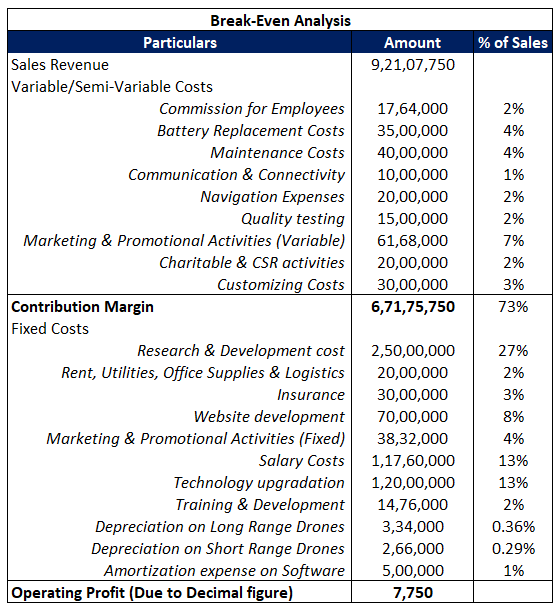
The break-even target is achievable but at the same time it might be challenging with the existing drone fleet of just 5 drones available and hence, it is suggested that the division can expand the fleet by purchasing 5 more drones, this will reduce the number of deliveries required per hour to achieve the Break-even. Alternatively, the division can continue with the existing fleet but this will push the break-even duration longer and won’t be able to achieve the objective.
Recommendations for the division:
- The division must consider and explore opportunities in different industries to expand its business subsequently.
- Since the business already has an established network and brand image in the market, it should try to leverage that as much as possible save the cost, and capture market share.
- All the departments must adhere to the budgeted allocation specific to their departments as any over-spending would lead to extra costs.
- Departments must also try to reduce spending by identifying the highest cost factor to improve the efficiency of the division.
- The division can also look to expand the business by entering into the B2C segment after the feasibility check and if it's suitable to enter and profitable.
Conclusion
Understanding the Expense Side of the Drone Division: The budget allocation for the Drone Division has been strategically planned to achieve the division's goals and ensure financial sustainability. Fixed costs, including personnel salaries, software development, and management, have been accounted for, while variable costs such as drone operations, maintenance, and insurance have been identified. The decision to consider only the depreciation and amortization expense for break-even analysis aligns with accounting principles and provides a more accurate representation of the costs relevant to the specific period. Assumptions: The assumptions made regarding battery replacement, insurance, communication, navigation, support services, weather-related costs, customized services, and depreciation are critical considerations in understanding the variable costs associated with drone operations. These assumptions provide a foundation for estimating expenses based on real-world operational scenarios. Budget Allocation: The budget has been judiciously allocated across various departments, including Research and Development, Operations and Logistics, Human Resources, Marketing and Promotion, Technology and Software, Contingency and Risk Management, Website Development, Charitable and CSR Activities, and Drone Acquisition. Each allocation is justified based on the specific needs and goals of the division, ensuring a comprehensive and strategic use of resources. Understanding the Revenue Side of the Drone Division: The pricing strategy for the B2B segment recognizes the competitive nature of the market, emphasizing the need for competitive pricing to capture market share. The consideration of cost advantages, absence of delivery partners, and operational efficiencies positions the drone-based delivery service as a cost-effective solution. The strategy anticipates a potential shift in pricing when entering the B2C segment, allowing flexibility based on market dynamics. Achieving Break-Even: The break-even analysis reveals that the division needs to achieve an average of 10,094 deliveries daily at a price of Rs. 25 per delivery to cover all fixed and variable costs. While the target is challenging with the current drone fleet, expansion or efficient utilization of existing resources can enhance the likelihood of achieving the break-even point. Recommendations: To achieve the division's goals, the focus should be on exploring opportunities in different industries, leveraging the existing network and brand image, adhering to budget allocations, identifying cost reduction opportunities, and considering expansion into the B2C segment after a feasibility check. In summary, the budget and strategies outlined provide a comprehensive financial plan for the Drone Division, ensuring a balance between expenses and revenue generation while fostering innovation and market leadership.Attached File Details
View Attachment file (BCS Solution Excel.pdf)Comments
Article Type: Business Case Scenario, Case Study Solution Submission
Business Case Detail
Title: NMO S5 Semi Final | BUSINESS CASE SCENARIO - 14 | Airway Delivery: A New Business Opportunity
Type: Case Study
Stream: Management
Participant
B.Com (Hons.) Graduate from Delhi University, worked for 2 years as an Analyst in Royal Bank of Scotland, NatWest Group. Currently pursuing Post Graduate Program in Management from Great Lakes Insititute of Management, Chennai
Team Agile Strategists - NMO S5 SF
Total Team Points: 116600
Team Visionary Trailsetters - NMO S5 SF
Total Team Points: 88000
Team Strategic Achievers - NMO S5 SF
Total Team Points: 118800